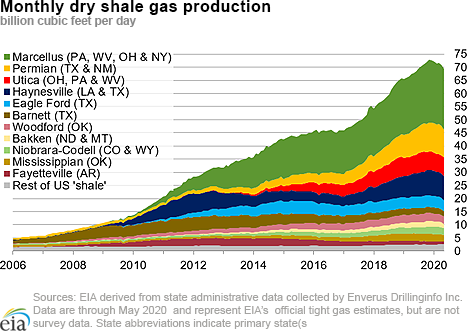In the News:
Henry Hub daily natural gas spot price reaches historic low
The average spot price of natural gas at the Henry Hub reached $1.38 per million British thermal units (MMBtu) on June 16, 2020, the lowest daily Henry Hub price without adjusting for inflation and in nominal dollars since December 1998, according to data from Natural Gas Intelligence. After starting 2020 relatively low, the price at Henry Hub so far this summer has continued to trend low because of high natural gas storage levels and declines in natural gas demand, specifically in exports of liquefied natural gas (LNG) feedgas and in the industrial sector.
Following a mild winter, natural gas inventories ended the heating season on April 30 at 21% (395 billion cubic feet (Bcf)) higher than the five-year average and 50% (772 Bcf) higher than last year’s end-of-season levels. Since then, those differences have continued to remain wide as a result of falling demand, which has increased net natural gas injections into storage. As of June 12, natural gas storage levels were 17% (419 Bcf) higher than the five-year average and 33% (722 Bcf) higher than last year. High storage levels indicate high natural gas production relative to consumer demand. The June Short-Term Energy Outlook (STEO) forecasts record natural gas in storage of nearly 4.1 trillion cubic feet by the end of October 2020.
Low feedgas volumes delivered to LNG export terminals in recent weeks have also put downward pressure on natural gas prices. Natural gas deliveries to LNG terminals have averaged 4.0 billion cubic feet per day (Bcf/d) so far in June according to IHS Markit, which is 1.4 Bcf/d lower than feedgas volumes last year and more than 5.0 Bcf/d lower than the record-high feedgas volumes that IHS Markit estimated in late March.
In addition, less business and manufacturing activity stemming from the policies put in place to mitigate the spread of the 2019 novel coronavirus disease (COVID-19) have also led to weaker natural gas demand from industrial consumers. Estimates from S&P Global Platts suggest that average industrial natural gas consumption in June 2020 has declined about 2.1 Bcf/d, or 9.6%, compared to June 2019.
Low natural gas prices so far this summer have resulted in increased natural gas consumption by electric power plants (power burn) because natural gas has become more competitive for electricity generation compared to competing fuel sources, such as coal. Average daily power burn is up about 6% in June compared to last year. This increase occurred despite essentially flat demand growth for electricity so far this June.
Another effect of historically low natural gas prices is declining natural gas production. According to data from IHS Markit, dry production totaled about 90 Bcf/d in June, down nearly 3.7 Bcf/d from March 2020. The recent declines in demand have outpaced the declines in production, putting downward pressure on Henry Hub prices. However, further declines in natural gas production are expected as a result of lags between natural gas price changes and adjustments to production levels. The June STEO forecasts dry production to continue declining steadily, reaching a low of 84.2 Bcf/d in May 2021. Declines in natural gas production will put upward pressure on the Henry Hub price in the coming months. The June STEO expects higher natural gas prices by the end of 2020, forecasting Henry Hub to average $2.95/MMBtu in December.
Overview:
(For the week ending Wednesday, June 24, 2020)
- Natural gas spot prices rose at most locations this report week (Wednesday, June 17 to Wednesday, June 24). The Henry Hub spot price rose from $1.48 per million British thermal units (MMBtu) last Wednesday to $1.58/MMBtu yesterday.
- At the New York Mercantile Exchange (Nymex), the price of the July 2020 contract decreased 4¢, from $1.638/MMBtu last Wednesday to $1.597/MMBtu yesterday. The price of the 12-month strip averaging July 2020 through June 2021 futures contracts declined 8¢/MMBtu to $2.286/MMBtu.
- The net injections to working gas totaled 120 billion cubic feet (Bcf) for the week ending June 19. Working natural gas stocks totaled 3,012 Bcf, which is 33% more than the year-ago level and 18% more than the five-year (2015–19) average for this week.
- The natural gas plant liquids composite price at Mont Belvieu, Texas, rose by 1¢/MMBtu, averaging $4.43/MMBtu for the week ending June 24. The prices of ethane, butane, and isobutane fell by 4%, 3%, and 1%, respectively. The prices of natural gasoline and propane rose by 5% and 4%, respectively. The continuing drop in the natural gasoline price reflects stock overbuild.
- According to Baker Hughes, for the week ending Tuesday, June 16, the natural gas rig count decreased by 3 to 75. The number of oil-directed rigs fell by 10 to 189. The total rig count decreased by 13, and it now stands at 266.
Prices/Supply/Demand:
Prices rise at most locations in the Lower 48 states. This report week (Wednesday, June 17 to Wednesday, June 24), the Henry Hub spot price rose 10¢ from $1.48/MMBtu last Wednesday to $1.58/MMBtu yesterday after reaching a high of $1.60/MMBtu on Monday. Higher prices come with mixed temperatures, with warmer-than-normal temperatures in the Northeast and cooler-than-normal temperatures over the Rockies and parts of the Midwest. At the Chicago Citygate, the price increased 8¢ from $1.51/MMBtu last Wednesday to $1.59/MMBtu yesterday.
California prices are up. The price at SoCal Citygate in Southern California increased 19¢ from $1.72/MMBtu last Wednesday to $1.91/MMBtu yesterday, with the price reaching a high of $2.12/MMBtu on Monday. The price at PG&E Citygate in Northern California rose 8¢, up from $2.28/MMBtu last Wednesday to $2.36/MMBtu yesterday.
Northeast prices rise during heat wave. At the Algonquin Citygate, which serves Boston-area consumers, the price went up 8¢ from $1.51/MMBtu last Wednesday to $1.59/MMBtu yesterday after reaching a high of $1.84/MMBtu on Monday. Temperatures in Boston were generally higher than 80 degrees Fahrenheit throughout the week, prompting increased demand for cooling. At the Transcontinental Pipeline Zone 6 trading point for New York City, the price increased 7¢ from $1.44/MMBtu last Wednesday to $1.51/MMBtu yesterday as temperatures reached monthly highs at the end of the report week.
The Tennessee Zone 4 Marcellus spot price increased 7¢ from $1.30/MMBtu last Wednesday to $1.37/MMBtu yesterday. The price at Dominion South in southwest Pennsylvania rose 9¢ from $1.31/MMBtu last Wednesday to $1.40/MMBtu yesterday.
Texas Eastern Transmission (TETCO) declares a force majeure On Tuesday, TETCO declared a force majeure on its entire 30-inch diameter pipeline spanning from Uniontown, Pennsylvania, to Kosciusko, Mississippi. The force majeure could reduce throughput capacity at Uniontown from 4.2 Bcf/d to 2.5 Bcf/d, according to estimates from Genscape.
Permian Basin discount to the Henry Hub narrows. The price at the Waha Hub in West Texas, which is located near Permian Basin production activities, averaged a low of $1.27/MMBtu last Wednesday, 21¢/MMBtu lower than the Henry Hub price. Yesterday, the price at the Waha Hub averaged $1.45/MMBtu, 13¢/MMBtu lower than the Henry Hub price.
Supply rises slightly, driven by an increase in imports from Canada. According to data from IHS Markit, the average total supply of natural gas rose by 0.6% compared with the previous report week. Dry natural gas production decreased by 0.3% compared with the previous report week. Average net imports from Canada increased by 13.0% from last week, with increased flows at border crossing points in the Northeast to meet regional demand.
Demand rises because of increased power generation. Total U.S. consumption of natural gas rose by 9.8% compared with the previous report week, according to data from IHS Markit. Natural gas consumed for power generation climbed by 20.5% week over week as temperatures increase following last week’s mild weather. In the residential and commercial sectors, consumption declined by 0.1%. Industrial sector consumption decreased by 1.0% week over week. Natural gas exports to Mexico increased 6.4%. Feedgas to liquefied natural gas (LNG) terminals on Wednesday increased 0.6 billion cubic feet per day (Bcf/d), or 18%, compared to last Wednesday, giving lift to prices.
U.S. LNG exports decrease week over week. Seven liquefied natural gas (LNG) vessels (three from Cameron, two from Sabine Pass, and one each from Cove Point and Corpus Christi) with a combined LNG-carrying capacity of 25 Bcf departed the United States between June 18 and June 24, 2020, according to shipping data provided by Marine Traffic.
Storage:
The net injections into storage totaled 120 Bcf for the week ending June 19, compared with the five-year (2015–19) average net injections of 73 Bcf and last year's net injections of 103 Bcf during the same week. Working natural gas stocks totaled 3,012 Bcf, which is 466 Bcf more than the five-year average and 739 Bcf more than last year at this time.
According to The Desk survey of natural gas analysts, estimates of the weekly net change to working natural gas stocks ranged from net injections of 99 Bcf to 116 Bcf, with a median estimate of 111 Bcf.
The average rate of injections into storage is 18% higher than the five-year average so far in the refill season (April through October). If the rate of injections into storage matched the five-year average of 8.8 Bcf/d for the remainder of the refill season, the total inventory would be 4,189 Bcf on October 31, which is 466 Bcf higher than the five-year average of 3,723 Bcf for that time of year.
More storage data and analysis can be found on the Natural Gas Storage Dashboard and the Weekly Natural Gas Storage Report.
See also:
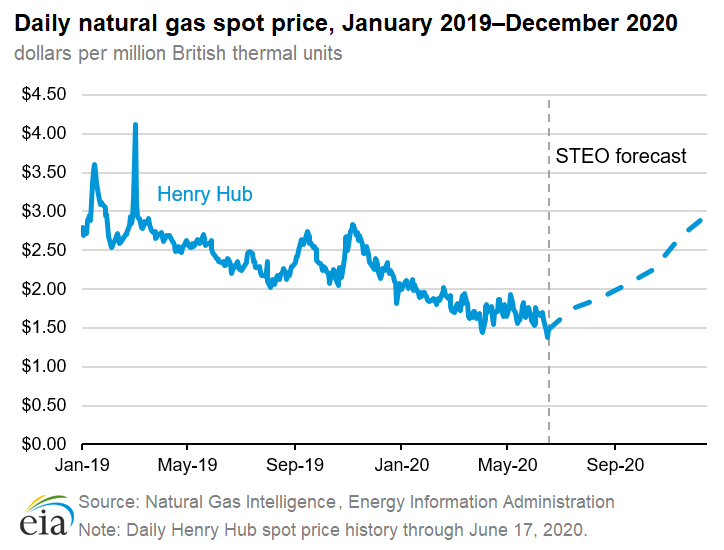
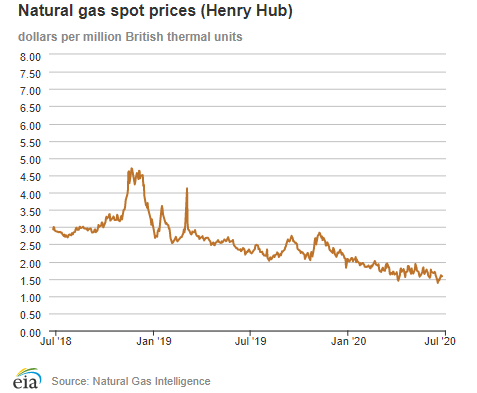
| Spot Prices ($/MMBtu) | Thu, 18-Jun |
Fri, 19-Jun |
Mon, 22-Jun |
Tue, 23-Jun |
Wed, 24-Jun |
|---|---|---|---|---|---|
| Henry Hub |
1.45 |
1.47 |
1.60 |
1.57 |
1.58 |
| New York |
1.42 |
1.44 |
1.70 |
1.58 |
1.51 |
| Chicago |
1.50 |
1.52 |
1.61 |
1.53 |
1.59 |
| Cal. Comp. Avg.* |
1.74 |
1.71 |
1.93 |
1.86 |
1.85 |
| Futures ($/MMBtu) | |||||
| July contract | 1.638 |
1.669 |
1.664 |
1.637 |
1.597 |
| August contract |
1.728 |
1.748 |
1.738 |
1.691 |
1.661 |
| *Avg. of NGI's reported prices for: Malin, PG&E Citygate, and Southern California Border Avg. | |||||
| Source: NGI's Daily Gas Price Index | |||||
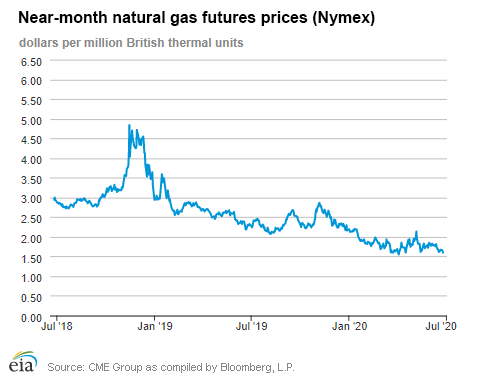
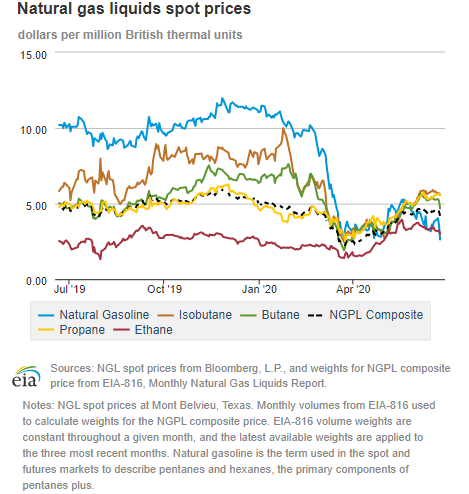
| U.S. natural gas supply - Gas Week: (6/18/20 - 6/24/20) | |||
|---|---|---|---|
Average daily values (Bcf/d): |
|||
this week |
last week |
last year |
|
| Marketed production | 101.3 |
101.6 |
102.3 |
| Dry production | 88.0 |
88.3 |
90.6 |
| Net Canada imports | 4.4 |
3.9 |
3.9 |
| LNG pipeline deliveries | 0.2 |
-0.1 |
0.1 |
| Total supply | 92.6 |
92.1 |
94.6 |
|
Source: IHS Markit | |||
| U.S. natural gas consumption - Gas Week: (6/18/20 - 6/24/20) | |||
|---|---|---|---|
Average daily values (Bcf/d): |
|||
this week |
last week |
last year |
|
| U.S. consumption | 65.8 |
59.9 |
62.4 |
| Power | 35.8 |
29.7 |
33.9 |
| Industrial | 20.7 |
20.9 |
19.5 |
| Residential/commercial | 9.2 |
9.3 |
9.0 |
| Mexico exports | 5.5 |
5.2 |
5.4 |
| Pipeline fuel use/losses | 5.4 |
5.4 |
6.2 |
| LNG pipeline receipts | 4.0 |
3.9 |
5.7 |
| Total demand | 80.7 |
74.3 |
79.7 |
|
Source: IHS Markit | |||
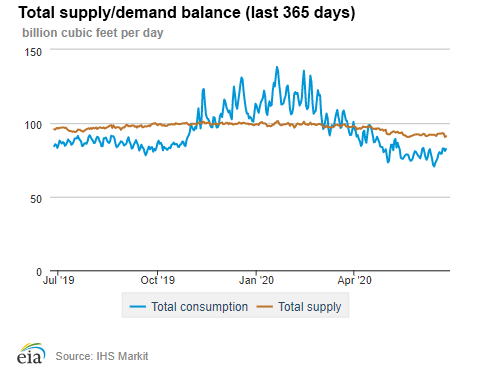
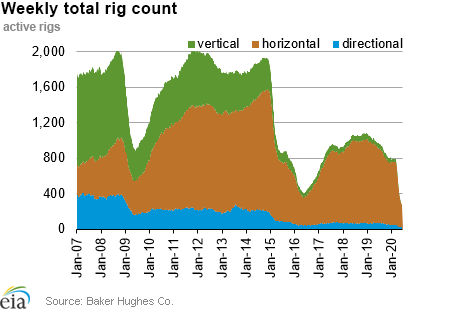
| Rigs | |||
|---|---|---|---|
Tue, June 16, 2020 |
Change from |
||
last week |
last year |
||
| Oil rigs | 189 |
-5.0% |
-76.0% |
| Natural gas rigs | 75 |
-3.8% |
-57.6% |
| Note: Excludes any miscellaneous rigs | |||
| Rig numbers by type | |||
|---|---|---|---|
Tue, June 16, 2020 |
Change from |
||
last week |
last year |
||
| Vertical | 14 |
27.3% |
-73.6% |
| Horizontal | 234 |
-4.9% |
-72.3% |
| Directional | 18 |
-18.2% |
-73.5% |
| Source: Baker Hughes Co. | |||
| Working gas in underground storage | ||||
|---|---|---|---|---|
Stocks billion cubic feet (Bcf) |
||||
| Region | 2020-06-19 |
2020-06-12 |
change |
|
| East | 619 |
586 |
33 |
|
| Midwest | 716 |
688 |
28 |
|
| Mountain | 165 |
156 |
9 |
|
| Pacific | 299 |
290 |
9 |
|
| South Central | 1,212 |
1,173 |
39 |
|
| Total | 3,012 |
2,892 |
120 |
|
|
Source: Form EIA-912, Weekly Underground Natural Gas Storage Report | ||||
| Working gas in underground storage | |||||
|---|---|---|---|---|---|
Historical comparisons |
|||||
Year ago (6/19/19) |
5-year average (2015-2019) |
||||
| Region | Stocks (Bcf) |
% change |
Stocks (Bcf) |
% change |
|
| East | 491 |
26.1 |
515 |
20.2 |
|
| Midwest | 528 |
35.6 |
571 |
25.4 |
|
| Mountain | 124 |
33.1 |
157 |
5.1 |
|
| Pacific | 242 |
23.6 |
284 |
5.3 |
|
| South Central | 888 |
36.5 |
1,019 |
18.9 |
|
| Total | 2,273 |
32.5 |
2,546 |
18.3 |
|
| Source: Form EIA-912, Weekly Underground Natural Gas Storage Report | |||||
| Temperature – heating & cooling degree days (week ending Jun 18) | ||||||||
|---|---|---|---|---|---|---|---|---|
HDD deviation from: |
CDD deviation from: |
|||||||
| Region | HDD Current |
normal |
last year |
CDD Current |
normal |
last year |
||
| New England | 18 |
6 |
-2 |
11 |
-2 |
4 |
||
| Middle Atlantic | 13 |
5 |
4 |
11 |
-15 |
-6 |
||
| E N Central | 20 |
10 |
-1 |
17 |
-17 |
4 |
||
| W N Central | 4 |
-6 |
-10 |
62 |
17 |
34 |
||
| South Atlantic | 5 |
4 |
3 |
56 |
-19 |
-18 |
||
| E S Central | 3 |
3 |
-1 |
50 |
-19 |
-15 |
||
| W S Central | 0 |
0 |
-1 |
98 |
-3 |
3 |
||
| Mountain | 13 |
-9 |
4 |
50 |
-3 |
-9 |
||
| Pacific | 12 |
-4 |
10 |
3 |
-19 |
-23 |
||
| United States | 11 |
2 |
2 |
37 |
-12 |
-6 |
||
|
Note: HDD = heating degree day; CDD = cooling degree day Source: National Oceanic and Atmospheric Administration | ||||||||
Average temperature (°F)
7-day mean ending Jun 18, 2020
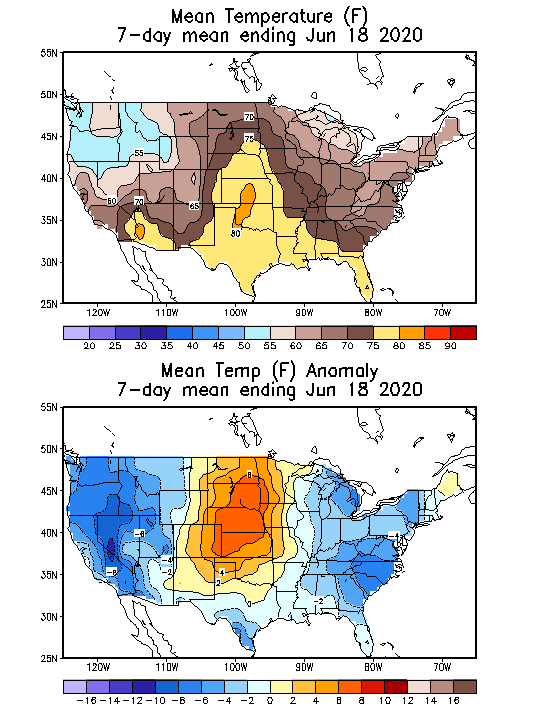
Source: National Oceanic and Atmospheric Administration
Deviation between average and normal (°F)
7-day mean ending Jun 18, 2020

Source: National Oceanic and Atmospheric Administration

